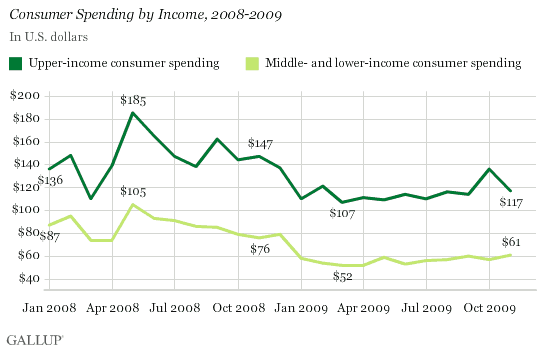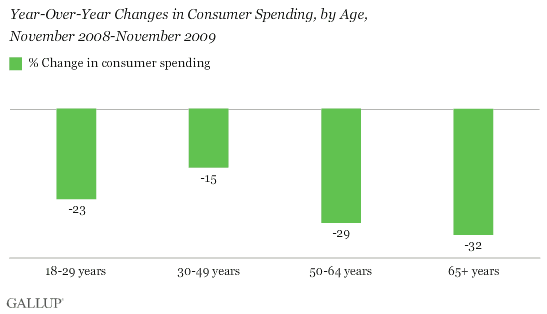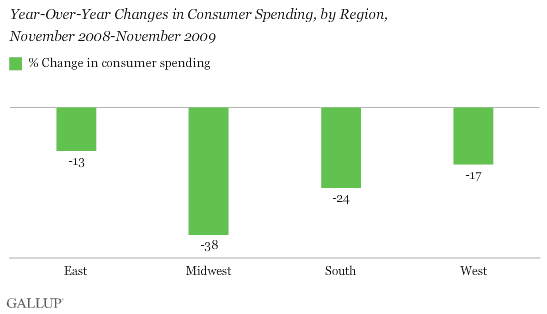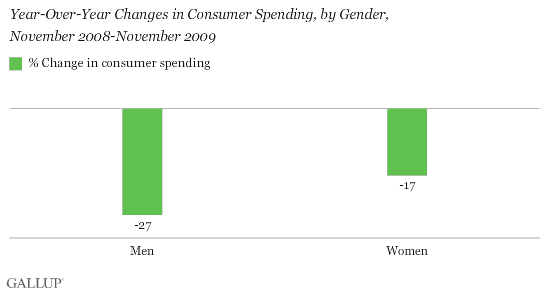PRINCETON, NJ -- In a sign that the new normal in consumer spending continues unabated, upper-income Americans' self-reported average daily spending in stores, restaurants, gas stations, and online fell 14% in November, reverting to its relatively tight ($107 to $121) pre-October 2009 average monthly range. Middle- and lower-income consumer discretionary spending increased by 7% last month but remained in its tight 2009 average monthly range of $52 to $61. Still, consumer spending by both income groups continues to trail year-ago levels by 20%, even as those comparables have gotten easier to match -- possibly dashing hopes that upscale retailers and big-ticket-item sales will do better this year.

Self-Reported Spending Down Across Incomes
Consumers' self-reported spending on discretionary items among middle- and lower-income Americans (those making less than $90,000 a year) was down 20% in November from the depressed spending levels of a year ago. As expected, this percentage decline from November 2008 is more modest than the year-over-year declines of earlier in the year as year-ago comparables have become easier to match. Although average daily spending among this group was technically at its high for 2009 last month, it continues to reflect a "new normal" spending pattern, staying within a tight $4 spending range that has persisted during the past four months.

"While the spending 'new normal' may not be good for the larger economy in the short-term, it may be seen as a strong positive for individual consumer households."
Spending among upper-income consumers (those making at least $90,000 a year) had reached its highest level of 2009 in October and had closed the gap to -6% compared to the same month a year ago. The hope was that the surge on Wall Street and the seeming stabilization of housing values had encouraged some upper-income consumers to abandon the 2009 spending new normal. November's results dashed these hopes, as upper-income consumers joined their middle- and lower-income counterparts in spending 20% less than they had during the financial crisis days of 2008 and returning to the relatively tight 2009 daily spending range for this group prior to October.
Self-Reported Spending Down Across Age Groups
Consumers in the child-rearing ages of 30 to 49 showed the smallest November-over-November discretionary spending decline at 15% -- possibly because they have the least ability to downshift their spending as the holidays approach. Younger consumers aged 18 to 29 experienced a larger decline of 23%. Those 50 to 64 years of age reduced their year-over-year spending by 29%, while those 65 or older had a decline of 32%. Overall, those in the 30 to 49 age group had the highest average daily spending level in November ($81), while those 65 or older spent the least per day ($52).

Self-Reported Spending Down Across Regions
Year-over-year consumer spending declined the least on the two coasts, with the East cutting average daily spending by 13% and the West cutting spending by 17%. The declines were largest in the Midwest -- down 38% -- while the South was in between, at 24%. Overall, consumer discretionary spending was highest in the East and West ($71 and $75 average per day, respectively) and lowest in the Midwest ($56).

Self-Reported Spending Down Across Genders
Overall, men claim greater average daily spending than women, possibly as a result of having higher average incomes and perhaps tending to more aggressively report joint spending. Men also report a larger decline in discretionary spending, at 27%, compared to the 17% self-reported by women.

Spending New Normal
Overall self-reported consumer discretionary spending has been essentially flat on a monthly basis throughout 2009 even when broken out by age, income, region, and gender. It has also been down significantly compared to the same months in 2008. The year-over-year differences have declined somewhat during recent months, but much of this closure in the 2008-2009 spending gap is a result of the easier spending comparables from last year's financial crisis.
Gallup's analysis of the relationship between job creation and consumer spending suggests that these lower spending levels are attributable, at least in part, to today's dismal job-market conditions. Further findings show that the current lack of job creation has its greatest impact on middle- and lower-income consumer spending.
In this regard, October upper-income spending provided new hope that the surge in the stock market and the increased stability of housing prices might be encouraging these consumers to break out of their year-long and relatively tight spending range. Instead, November's results show that upper-income spending reverted back to its new normal range. Given the greater discretionary spending flexibility of upper-income Americans, this reversion to the pre-October spending range tends to give added face-validity to the argument that a consumer spending new normal exists -- independent of the job situation -- as 2010 approaches.
On a national level, the spending new normal suggests slower economic growth than otherwise might be expected in the years ahead. In turn, reduced consumer spending will complicate the job-creation problem, not to mention fiscal and monetary policies. For example, one might argue that the federal government and monetary authorities (the Fed) need to take emergency actions to offset a temporary spending shortfall due to job losses, but the same arguments do not necessarily hold true when the spending reduction results from a new normal spending pattern -- generally speaking, the private sector needs to adjust to such changes in consumer behaviors.
For retailers, small businesses, and the companies that supply and support them, a new normal spending pattern can mean complex changes involving downscaling, upselling (people taking advantage to buy upscale for less), inventory management, and people-related adjustments. The U.S. economy is designed to allow the private sector to make such adjustments in order to optimize performance when faced with such a rapidly changing business environment. Of course, the same does not apply to maintaining the social safety net, particularly in the face of double-digit unemployment and even higher underemployment.
While the spending "new normal" may not be good for the larger economy in the short-term, it may be seen as a strong positive for individual consumer households. Consumers, like their business and banking counterparts, would be well-served to de-leverage by spending less, saving more, reducing their use of credit, and thereby strengthening their personal balance sheets. While this may not provide the immediate-term returns to the economy of the over-leveraging of recent years, a financially stronger U.S. consumer implies only good things for the longer-term wellbeing of both the U.S. and global economies.
Review and export the complete daily trends on these measures: ; ; ; ;
about Gallup's economic measures.
Survey Methods
For ÆéûÜǨû§Daily tracking, ÆéûÜǨû§interviews approximately 1,000 national adults, aged 18 and older, each day. The ÆéûÜǨû§consumer spending results are based on random half-samples of approximately 500 national adults, aged 18 and older, each day. Results for November are based on telephone interviews with more than 14,000 adults. For these results, one can say with 95% confidence that the maximum margin of sampling error is ôÝ1 percentage points. Results for the various breakout reported here are based on interviews with more than 1,000 respondents with a maximum margin of error of ôÝ3 percentage points.
Interviews are conducted with respondents on land-line telephones and cellular phones.
In addition to sampling error, question wording and practical difficulties in conducting surveys can introduce error or bias into the findings of public opinion polls.
